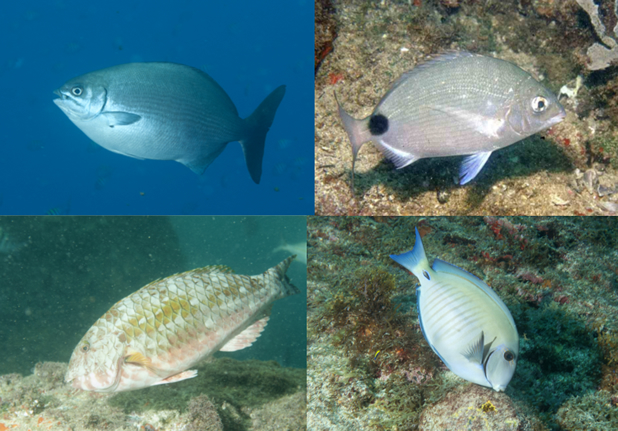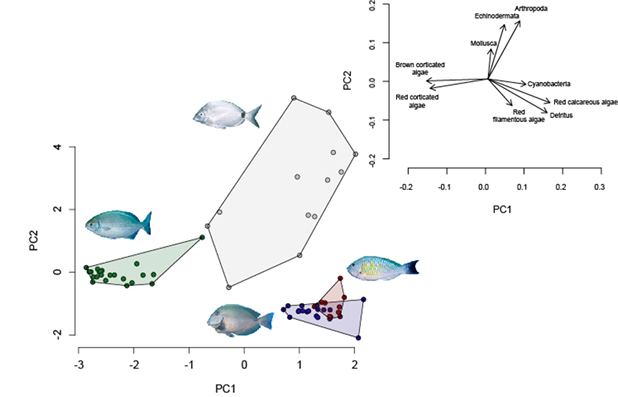New publication: Discordance between diet analysis and dietary macronutrient content in four nominally
herbivorous fishes from the Southwestern Atlantic
A new study published by LECAR members Thiago Mendes and Carlos Ferreira in collaboration with Kendall
Clements (University of Auckland) in Marine Biology compared diet composition with dietary % carbon, %
nitrogen and C:N ratios in four nominally herbivorous fish from Brazil. The chub Kyphosus sectatrix ingested mainly
carbon-rich corticated algae and the porgy Diplodus argenteus had a more variable, omnivorous diet, in accordance
to the expected. On the other hand, the parrotfish Sparisoma axillare and the surgeonfish Acanthurus chirurgus had
similar diets composed mainly by detritus and red algae, but presented distinct dietary nutritional profiles with S.
axillare ingesting four times the nitrogen and double the carbon content of A. chirurgus. This difference may be
related to the heterogeneous nature of detritus in the epilithic algal matrix in which these species feed, and the
difference in their food processing modes. These results indicate that conventional diet analysis do not reveal the
important specific differences in nutrient intake for some herbivorous fishes and highlight the necessity of a more
profound understanding of their nutritional ecology.
Um novo estudo publicado na revista Marine Biology pelos membros do LECAR Thiago Mendes e Carlos
Ferreira em colaboração com Kendall Clements (University of Auckland) comparou a composição da dieta com
o percentual de carbono, percentual de nitrogênio e razão C:N presentes na dieta de quatro espécies de peixes
herbívoros que ocorrem no Brasil. Como esperado, a pirajica Kyphosus sectatrix ingeriu basicamente algas
corticadas ricas em carboidratos fermentáveis e o marimbá Diplodus argenteus exibiu uma dieta mais variada,
típica de um peixe onívoro. Por outro lado, o peixe-papagaio Sparisoma axillare e o peixe-cirurgião Acanthurus
chirurgus tiveram uma dieta similar, composta predominantemente de detrito e algas vermelhas, mas
apresentaram um perfil nutricional muito diferente, com S. axillare ingerindo quatro vezes mais nitrogênio e o dobro
de carbono do que A. chirurgus. Essa diferença se deve à natureza heterogênea do detrito na matriz de algas
epilíticas, onde essas espécies se alimentam, e à diferença em seus modos de processamento de alimento.
Esses resultados indicam que análises convencionais de conteúdo alimentar não evidenciam importantes
diferenças interespecíficas na ingestão de nutrientes de algumas espécies de peixes herbívoros e ressaltam a
necessidade de um entendimento mais profundo de sua ecologia nutricional.

Figure 1. Upper left: Kyphosus sectatrix; upper right: Diplodus argenteus; bottom left: Sparisoma axillare; bottom
right: Acanthurus chirurgus.

Figure 2. Dietary overlap among the four study species.
Writen by: Thiago Mendes
November 2018
Mendes TC, Ferreira CEL, Clements KD. 2018. Discordance between diet analysis and dietary macronutrient
content in four nominally herbivorous fishes from the Southwestern Atlantic. Marine Biology, 165: 180.
doi.org/10.1007/s00227-018-3438-4 PDF |











